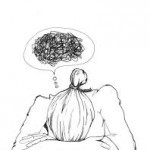This is an extremely relevant and useful guest post. I have come across many different formulas for a step-wise approach to recovery, but this is the most coherent and sensible one I’ve seen. The middle step is often our downfall, and Fred helps clarify the problem.
…by Fred…
In a recent post, Marc fleshed out the idea that addicts need to shift their perception of the tradeoff between their addictive behavior and the potential consequences of that behavior. It is well known that addicts tend to overvalue the current rewards of using, and undervalue the  potential rewards that might come from staying sober. One definition of addiction is “emotional immaturity and lack of discipline,” and it is this difficulty in seeing the big picture that trumps everything else when an addict tries to revalue the tradeoff between using and not using.
potential rewards that might come from staying sober. One definition of addiction is “emotional immaturity and lack of discipline,” and it is this difficulty in seeing the big picture that trumps everything else when an addict tries to revalue the tradeoff between using and not using.
In his book “In the Realm of Hungry Ghosts”, Gabor Maté builds on the work of Jeffrey Schwartz in laying out an approach to resisting relapse called “The 5 Rs”. When the urge to use occurs, the addict is encouraged to “Relabel” the thought (it’s just a thought, not a command), “Reattribute” the thought (it’s my old addictive pattern again – my brain’s old behavior), “Refocus” (distract and turn one’s mind to healthy activities), “Revalue” (play the tape forward and clarify all the negative consequences that could occur because of relapse), and finally “Recreate”, where the addict focuses attention on his or her dreams for a new sober life.
1. Relabel
2. Reattribute
3. Refocus
4. Revalue
5. Recreate
The 4th and 5th Rs, Revalue and Recreate, are explicitly about addressing the addict’s distorted thinking when weighing short-term payoffs against long-term chaos. But first, the addict needs to have enough mindfulness to consciously intervene in his or her own addictive cycle (the first 2 Rs). See the recent post by Matt Robert for more about how this works. At that point, it’s important to give the mind something else to do — to interrupt the cycle. This is where the third R comes in — Refocus. This is a process that combines distraction and substitution to stop the addictive thought process and ritual, and, ideally, to address the deeper needs underlying the urge to use.
Addicts use, in part, as a form of mood regulation. The addictive ritual and behavior releases nature’s mood enhancers — endorphins, dopamine, serotonin, noradrenaline and  adrenaline. Stress, boredom, loneliness, grief, resentment and other uncomfortable feelings can all create a desire for refuge and an urge to use. Sometimes, simply being exposed to a certain place, or image, or a particular person, can start the cycle. Revaluing and Recreating in that scenario are probably not going to be strong enough, especially in early recovery, to interrupt the cycle and protect the addict from relapse. That’s because the unpleasant mood state that the addict is in (which is often accompanied by negative physical sensations) is difficult to tolerate, and the future benefits of staying sober are merely conceptual. They alone won’t shift the mood. This is where Refocusing (i.e., distraction and substitution) is critical. By getting away from the immediate stimulus and unsafe environment, and focusing the body and mind on a healthy substitute activity, the addict has a better chance of riding out the urge to use, and sometimes directly address the underlying stressor and associated emotions.
adrenaline. Stress, boredom, loneliness, grief, resentment and other uncomfortable feelings can all create a desire for refuge and an urge to use. Sometimes, simply being exposed to a certain place, or image, or a particular person, can start the cycle. Revaluing and Recreating in that scenario are probably not going to be strong enough, especially in early recovery, to interrupt the cycle and protect the addict from relapse. That’s because the unpleasant mood state that the addict is in (which is often accompanied by negative physical sensations) is difficult to tolerate, and the future benefits of staying sober are merely conceptual. They alone won’t shift the mood. This is where Refocusing (i.e., distraction and substitution) is critical. By getting away from the immediate stimulus and unsafe environment, and focusing the body and mind on a healthy substitute activity, the addict has a better chance of riding out the urge to use, and sometimes directly address the underlying stressor and associated emotions.
 When confronted with stress, a young child seeks comfort in the arms of a caregiver. The endorphins released by the loving touch and soothing presence of the attachment figure help to calm the child. Adults also experience endorphin release as a result of intimate touch and connection with others. But, for the addict, this source of endorphins is typically unavailable — the addiction makes safe intimate relationships impossible. Similarly, the elevated dopamine levels that accompany craving make it difficult for the addict to focus on anything but the anticipated high, thereby ignoring everyday activities that might otherwise be rewarding and satisfying. The addict’s artificial mood regulation strategy cuts off the ability to regulate in healthy ways — through close relationships and meaningful activities.
When confronted with stress, a young child seeks comfort in the arms of a caregiver. The endorphins released by the loving touch and soothing presence of the attachment figure help to calm the child. Adults also experience endorphin release as a result of intimate touch and connection with others. But, for the addict, this source of endorphins is typically unavailable — the addiction makes safe intimate relationships impossible. Similarly, the elevated dopamine levels that accompany craving make it difficult for the addict to focus on anything but the anticipated high, thereby ignoring everyday activities that might otherwise be rewarding and satisfying. The addict’s artificial mood regulation strategy cuts off the ability to regulate in healthy ways — through close relationships and meaningful activities.
Refocusing not only helps the addict stay sober until the urge to use passes, it can actually start inculcating new mood regulation habits. Instead of relapsing in response to a trigger, the addict might develop the habit of picking up the phone and calling a friend in recovery, or  going to a 12-step meeting, or exercising, or reading a novel, or doing a kindness for someone in need. These types of activities will not only provide a distraction, they will substitute a behavior that reduces stress in a healthy way and helps to alleviate negative moods.
going to a 12-step meeting, or exercising, or reading a novel, or doing a kindness for someone in need. These types of activities will not only provide a distraction, they will substitute a behavior that reduces stress in a healthy way and helps to alleviate negative moods.
Faced with pain from life, our addictions temporarily soothe us, but they leave us more alone, and even more vulnerable to pain. It’s suicide on the installment plan. In recovery, faced with pain from life, we replace the mood-regulation strategy of addiction with caring for ourselves and connecting with others. Consoled, we begin to believe in, and create, a future free from addiction and filled with the blessings of a life worth living.

Leave a Reply